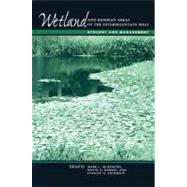Wetland and Riparian Areas of the Intermountain West : Ecology and Management
, by McKinstry, Mark C.- ISBN: 9780292702486 | 0292702485
- Cover: Hardcover
- Copyright: 7/1/2004
Wetlands and riparian areas between the Rocky Mountains and the Sierra Nevada are incredibly diverse and valuable habitats. More than 80 percent of the wildlife species in this intermountain region depend on these wetlands--which account for less than 2 percent of the land area--for their survival. At the same time, the wetlands also serve the water needs of ranchers and farmers, recreationists, vacation communities, and cities. It is no exaggeration to call water the "liquid gold" of the West, and the burgeoning human demands on this scarce resource make it imperative to understand and properly manage the wetlands and riverine areas of the Intermountain West. This book offers land managers, biologists, and research scientists a state-of-the-art survey of the ecology and management practices of wetland and riparian areas in the Intermountain West. Twelve articles examine such diverse issues as laws and regulations affecting these habitats, the unique physiographic features of the region, the importance of wetlands and riparian areas to fish, wildlife, and livestock, the ecological function of these areas, their value to humans, and the methods to evaluate these habitats. The authors also address the human impacts on the land from urban and suburban development, mining, grazing, energy extraction, recreation, water diversions, and timber harvesting and suggest ways to mitigate such impacts.In addition to the editors, the contributors to this volume are:Paul Adamus, Oregon State University, CorvallisMichael A. Bozek, University of Wisconsin, Stevens PointRobert C. Ehrhart, Oregon State University, BendJames H. Gammonley, Colorado Division of Wildlife, Fort CollinsPaul L. Hansen, Bitterroot Restoration, Corvallis, MontanaE. Andrew Hart, University of Wyoming, LaramieMurray K. Laubhan, U.S. Geological Survey, Fort Collins, ColoradoKirk Lohman, University of Idaho, MoscowJames R. Lovvorn, University of Wyoming, LaramieNeal D. Niemuth, University of Wisconsin, Stevens PointRichard A. Olson, University of Wyoming, LaramieNeil F. Payne, University of Wisconsin, Stevens PointMark A. Rumble, U.S. Department of Agriculture, Forest Service, Rocky Mountain Research Station, Rapid City, South DakotaMaureen Ryan, University of Toledo (Ohio) College of LawBrian E. Smith, U.S. Geological Survey, Northern Prairie Wildlife Research Center, Jamestown, North DakotaMark Squillace, University of Toledo (Ohio) College of LawStephen A. Tessmann, Wyoming Game and Fish Department, CheyenneDavid W. Willis, South Dakota State University, Brookings






